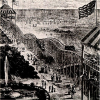BarnBuster
Virtually Unknown Member
On June 15, 1943, Paul Blobel, an SS colonel, is given the assignment of coordinating the destruction of the evidence of the grossest of Nazi atrocities, the systematic extermination of European Jews.
As the summer of 1943 approached, Allied forces had begun making cracks in Axis strongholds, in the Pacific and in the Mediterranean specifically. Heinrich Himmler, leader of the SS, the elite corps of Nazi bodyguards that grew into a paramilitary terror force, began to consider the possibility of German defeat and worried that the mass murder of Jews and Soviet prisoners of war would be discovered. A plan was devised to dig up the buried dead and burn the corpses at each camp and extermination site. The man chosen to oversee this yearlong project was Paul Blobel.
Blobel certainly had some of that blood on his hands himself, as he was in charge of SS killing squads in German-occupied areas of Russia. He now drew together another kind of squad, “Special Commando Group 1,005,” dedicated to this destruction of human evidence. Blobel began with “death pits” near Lvov, in Poland, and forced hundreds of Jewish slave laborers from the nearby concentration camp to dig up the corpses and burn them—but not before extracting the gold from the teeth of the victims. Blobel was executed by hanging at Landsburg Prison on June 7, 1951.
Aktion 1005
Encyclopedia of Jewish and Israeli history, politics and culture, with biographies, statistics, articles and documents on topics from anti-Semitism to Zionism.













